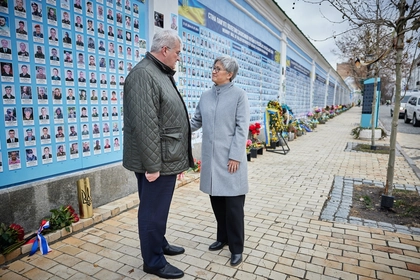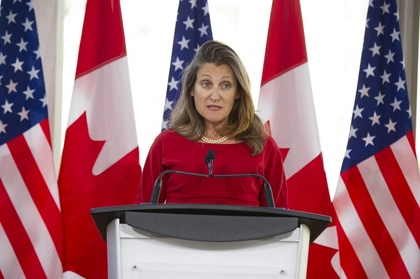The split among the Ukrainian American diaspora in these final days of the 2024 presidential election stems not only because of the differing political approaches of the two parties toward supporting Ukraine in its war with Russia but also from key factors such as demographics and religion within the community.
However, Donald Trump’s rhetoric towards Ukraine has further polarized Ukrainian Americans, intensifying debates over US involvement. Whichever candidate wins will likely set the US on a divergent path in its support for Ukraine, with each offering a distinctly different vision for the nation’s role in helping Ukraine defend itself against Russia.
JOIN US ON TELEGRAM
Follow our coverage of the war on the @Kyivpost_official.
Historical waves of Ukrainian immigration to the US
Ukrainians have had a presence in America since 1607, with Ivan Bohdan having arrived alongside John Smith in Jamestown. There was a major wave of Ukrainian immigration to the US in the 1890s followed by successive influxes after both World Wars, as many Ukrainians fled persecution.
The largest wave, however, came in the early 1990s, following the collapse of the Soviet Union, as Ukrainians sought greater freedom and opportunities. Many of these post-Soviet emigrants were Jewish or Protestant, predominantly ethnic Ukrainians, who left due to the severe repression faced by both groups under Soviet rule.
Oleh Wolowyna, director of the Center for Demographic and Socio-Economic Research of Ukrainians in the US at the Shevchenko Scientific Society in New York, offers insight into Ukrainian immigration patterns and religious affiliations:

Australian Foreign Minister Visits Kyiv, Confirms Reopening of Embassy
“About two-thirds of Ukrainians who came to the US in the 1980s were born in Soviet Ukraine, and about 20 percent came from Canada,” Wolowyna explains. “More than 80 percent of Ukrainian immigrants to the U.S. in the 1990s and 2000s came from Ukraine, while the migration stream from Canada became negligible.”
Wolowyna highlights how Soviet emigration policies limited migration until the Jackson-Vanik amendment of the Trade Act of 1974, signed by President Ford in 1975, which allowed those persecuted for religious beliefs to emigrate.
“Most of these emigrants were Jews, some were evangelical Christians, and a few were Catholics,” he says. After Ukraine’s independence in 1991, the composition of Ukrainian immigrants shifted from predominantly Jewish to a larger proportions of ethnic Ukrainians.
However, there are major differences among those Ukrainians who immigrated in each wave.
“Most WWII refugees were Ukrainian Catholics from Western Ukraine,” Wolowyna says, highlighting that these migrants generally held a strong Ukrainian identity and were motivated by political factors. In contrast, “migrants following Ukraine’s independence were mainly economic migrants; for many of whom, Ukrainian identity was not as strong.”
The role of religion in Ukrainian American politics
Religion plays a significant role in shaping political leanings within the Ukrainian American community. According to Anastasia Kharitonova-Gomez, a Ukrainian American, whose graduate studies research focused on Ukrainian Americans’ social and political roles, religious affiliation often dictates partisanship within the diaspora.
“One of the strongest factors shaping Ukrainian partisanship is religious affiliation,” she explains. “Ukrainians are a majority Christian group. Most of Ukraine is Orthodox and Catholic, and only a small percentage are Protestant. This is flipped in the diaspora, because a large number of Ukrainians who immigrated in recent decades are Protestants, particularly of Baptist and Pentecostal denominations.”
This divide contributes to the community’s split over the election. Politically, evangelical Protestants strongly lean Republican, a trend also seen among Ukrainian American Protestants.
“Among Catholic and Orthodox Ukrainians, there is a reported conservative tilt, but also more variation,” Kharitonova-Gomez explains.
“Those with no religious affiliation or non-evangelical Protestants tend to prefer Democrats.”
Ultimately, her research suggests that “Ukrainian identity and concern for Ukraine are rarely the primary factors influencing who Ukrainian Americans vote for,” with religious affiliation often playing a decisive role.
Conservative leanings shaped by immigration policies
Favorable immigration policies and support from church sponsors allowed entire Soviet congregations to relocate to the Pacific Northwest and California in the fourth wave.
Kharitonova-Gomez says, “The conservative lean is stronger in the Washington State diaspora than in many other states, due to the large number of people who arrived through the Lautenberg program and the resulting family-based immigration that flows from that.” The program primarily benefited Protestant families, further embedding conservative values within the state’s Ukrainian American community.
In 1989, the US Congress passed the Lautenberg Amendment, which further facilitated the resettlement of persecuted minorities from the Soviet Union. Protestant Christians, including Baptists and Evangelicals, who could demonstrate “well-established histories of persecution,” were eligible to immigrate.
Over the following decades, around 500,000 Soviet Evangelicals, most of whom were from Ukraine, resettled in the US, either as refugees or through family reunification. Even today, many of the Ukrainians fleeing the Russia’s 2022 full-scale invasion are Protestant Ukrainians, joining family and friends who have already established themselves in the US.
Soviet Evangelicals, in particular, adapted their cultural and religious values to a doctrine that aligned them with Donald Trump, whom they saw as a defender of their conservative principles. This is due to their severe persecution under the Soviet regime, leading the group to be suspicious of the government and as a result, religion has been the primary driver of their identity.
Generational differences affecting Ukrainian Identity
Differences among immigration waves reveal generational shifts in Ukrainian identity.
“Members of the third wave of Ukrainian immigration, who arrived in the 1940s-50s, have critiqued the fourth wave - those arriving from the late 1980s to recent years - as lacking sufficient patriotism and being overly influenced by Soviet ideology,” Kharitonova-Gomez says
“Many fourth-wave migrants came to the U.S. for economic opportunities rather than for political or ideological reasons and often express more ambivalence about Ukrainian independence.”
Religious affiliation also shapes generational perspectives. “Protestant Ukrainians, many of whom are part of the fourth wave, are known to prioritize their faith over their cultural, ethnic, or national identity,” Kharitonova-Gomez says.
Third-wave immigrants, by contrast, often blend faith, culture, and national pride, placing a high value on their Ukrainian identity. These differences reflect the complex landscape within the Ukrainian American community, where each wave’s unique experience of Ukraine’s history influences their cultural and political connections to their heritage.
The appeal of Trump to Ukrainian Americans
Maksim Pazyuk, born in Berdychiv, Ukraine, and raised in Sacramento, California, is a Ukrainian American who holds strong pro-Trump views.
When asked about his thoughts on Trump’s approach to engaging with Putin, Pazyuk responded, “Yes, it is concerning; however, with so many nations supporting Ukraine, we also need to consider what is best for the country we live in. I believe that Trump supports Ukraine in his own way, and if re-elected, he would work to bring an end to the war rather than allowing Ukraine to be defeated. In war, no one truly wins, so I feel that finding a way to end this conflict, whatever the outcome, is better than seeing more lives lost.”
“I believe Biden’s actions reflect a lack of alignment with Christian values. For example, on Easter - a day when Christians celebrate the resurrection of Jesus - he chose to recognize Transgender Day, which, to me, shows where his priorities lie,” Paziuk says.
“Coming from a conservative Christian background, I find it difficult to support actions that go against those values.
“On the other hand, Trump demonstrated his stance by removing transgender individuals from military service, which I feel aligns more closely with traditional principles," Pazyuk says.
Mixed feelings on Trump’s stance toward Ukraine
While many Ukrainian Americans appreciate Trump’s conservative policies, his recent comments on Ukraine present a dilemma for some.
Peter Manelyuk, a Ukrainian American from Vancouver, Washington, expresses frustration with Trump’s stance, particularly following his statement blaming NATO and Ukraine for Russia’s invasion. “How can someone put ‘America First’ while excusing the behavior of brutal dictators?” he asks.
Frustrated by Trump’s promise to end the war in 24 hours without any clear plan, Manelyuk feels that many Ukrainians may still support him out of habit or past admiration. “Many Ukrainians support him based on his past policies, assuming he’ll somehow stop the war, but his views on Ukraine are misguided,” he concluded, adding that he was doubtful Trump’s priorities toward Ukraine would change if he’s re-elected.
Similarly, Mikhail Pavenko, a Ukrainian American from Sloviansk, Donetsk Oblast, residing in Clark County, Washington, feels conflicted. “That’s a million-dollar question,” he says of Trump’s potential foreign policy. “I am not that worried. I think there are many smart people who will explain to senior leaders in America that Russia is not to be trusted.”
Although some in the Republican Party have pushed for reduced aid to Ukraine, Pavenko remains hopeful that continued advocacy, and education will shape a more supportive stance within the party. For Pavenko, the stakes are clear: “The Russian propaganda has done a great job, sadly, of controlling the narrative within the GOP, but even that is changing for the better. We need to stay focused, work harder, and believe that God will work a miracle for the nation of Ukraine.”
Ukrainian American support for the Democrats
In contrast, some Ukrainian Americans, particularly among those who arrived during earlier immigration waves and settled in the Midwest and East Coast, are increasingly aligning with Vice President Kamala Harris and the Democratic Party.
Historically, these waves of Ukrainian Americans leaned Republican, driven by the party’s strong opposition to Communism, championed by leaders like Ronald Reagan. This anti-Soviet sentiment or anti-Russian imperialism sentiment continues to shape their views, especially in light of Russia’s aggression toward Ukraine.
Ukrainian Americans like Orest Deychakiwsky, who previously worked with the US Helsinki Commission and also belongs to the older waves of immigrants to the US who have helped establish the Ukrainian Americans for Harris-Walz Steering Committee. This shows a shift with the Democratic Party moving towards a more Reagan-like stance in countering Russian imperialism, taking some of the Ukrainian American vote, as it increasingly positions itself as a defender of Ukraine in the face of Russian aggression.
Mark Temnycky, a Ukrainian American from the East Coast, speaking about the older Ukrainian American diaspora, said, “There is still a segment of the Ukrainian American population that intends to vote for former President Trump, although some do not openly admit it. They have criticized President Biden saying the administration is too slow and is not doing enough for Ukraine.”
A complex choice for Ukrainian American voters
As the 2024 election approaches, the Ukrainian American community remains divided over which candidate to support. For many from the fourth wave of immigration, whose Ukrainian identities were significantly shaped by Soviet repression, religious affiliation often guides political preferences. Kharitonova-Gomez concludes, “I can say with considerable confidence that most Ukrainians in Washington State will vote for Trump. Based on my research, I suspect that most Ukrainians in the U.S. who are eligible to vote will do so as well, though there is variation in partisanship across states and generations.”
The views expressed in this opinion article are the author’s and not necessarily those of Kyiv Post.
You can also highlight the text and press Ctrl + Enter






